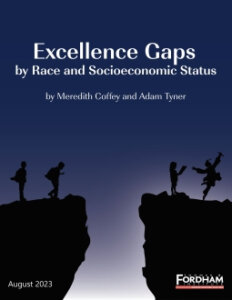 The Thomas B. Fordham Institute released a new report titled Excellence Gaps by Race and Socioeconomic Status. Using reading and math NAEP data for 8th graders over the last two decades, it provides important insight into the performance of the nation’s highest achieving students (i.e. those who earned “Advanced” scores) over time, and broken down by both race/ethnicity and socioeconomic status (SES).
The Thomas B. Fordham Institute released a new report titled Excellence Gaps by Race and Socioeconomic Status. Using reading and math NAEP data for 8th graders over the last two decades, it provides important insight into the performance of the nation’s highest achieving students (i.e. those who earned “Advanced” scores) over time, and broken down by both race/ethnicity and socioeconomic status (SES).
Specifically, the study authors explore:
- To what extent can racial/ethnic “excellence gaps,” or disparities in academic performance among groups of students performing at the highest levels, be explained by differences in SES?
- Are excellence gaps still apparent when racial/ethnic groups are compared within the same socioeconomic groups?
- How have excellence gaps by race/ethnicity and SES shifted over the past two decades, including since the COVID-19 pandemic?
Fordham’s Adam Tyner and Meredith Coffey find that even within SES groups, racial/ethnic excellence gaps persist, and that SES has a similar effect on all racial/ethnic groups. They also find that over the last two decades, Advanced achievement levels generally rose for all racial/ethnic and SES groups, but particularly for Asian American and Pacific Islander students. Since the pandemic, however, Advanced achievement levels have declined for all racial/ethnic groups (most notably in math).
The report ends with policy implications for boosting Advanced achievement for all student groups while also working to narrow excellence gaps.